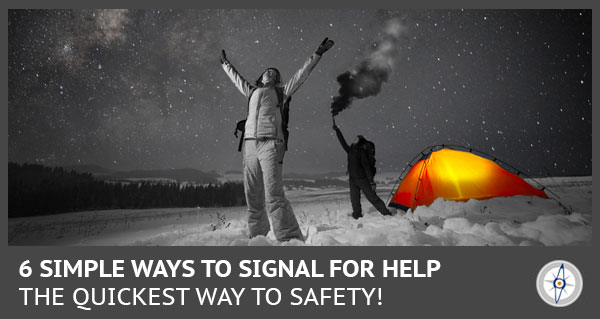
There are two sides to every survival situation. There is what you see on television, and then there is reality. Many people think that survival is all about building a nifty shelter and hunting with a hand-carved spear. Surely those skills can be helpful, but there are other ways to survive. The four pillars of survival are food, water, fire, and shelter. However, signaling for help should really be added to that list. It is often your quickest way to safety.
Why Signal?
If you really think about it, there are very few situations where you would go missing and somebody would not be looking for you. Even if you live alone, have no family or friends, and have no job, you still have a record of almost everywhere you could go.
Most parks and wilderness areas require you to sign in before you head off into the wild. For the majority of us, family or friends would know our plans and start to worry within 24 hours. This means that help is out there if you can only find a way to reach your rescuers.
If you do not know how to properly signal for help, you drastically reduce your chances of rescue. The odds of rescue personnel getting close enough to your location to distinguish your figure from the surrounding wilderness are not good. In most cases, these rescuers have a fairly large area to cover and cannot put boots on every square foot of land. But, they likely can get close enough to see a visual signal or hear an audible signal.
Contrast
The key to any successful signal is contrast. You want to find ways to make your signal stand out from its surroundings. If you are on a snowy hill, then dark colors will stand out. On a dark limestone slab, light colors will stand out. If the sky is full of white clouds, then dark signals work best, but if the sky is blue and clear, then white signals may be better. In the wilderness, bright colors are always a great way to create contrast.
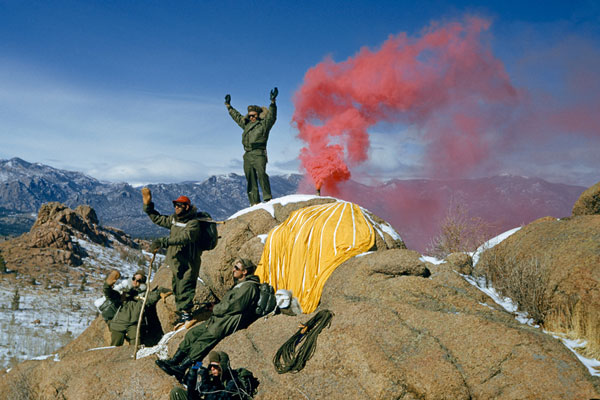
via nationalgeographic.com
Movement is another way to create contrast, as your background will most likely be still. Rescuers are trained to look for this. In addition, distinct sounds can create contrast. If you are in the wilderness, the sound of a car horn or of clanging metal will stand out. You want to create contrast with as many senses as possible. Even smells can have contrast. If a rescuer smells burning rubber in the middle of a forest, they know to check that area.
Unnatural shapes are one of the best ways to create contrast. Many geometric shapes are never seen in a natural setting, so they stand out well. In addition, patterns and letters are rarely seen in the wild. Patterns and letters can be written out to create stationary contrast, or they can be created using movement, light, or sound.
Consider Your Circumstances
One of the most important aspects of signaling is the decision of how to signal. In the end, more signals are better. However, you do want to prioritize your signaling efforts based on what you feel will be most effective. For example, a stationary ground to air signal such as writing out a big ‘SOS’ in a dense forest probably will not make much of a difference. In this case, a smoke signal or audible signal will be more effective.
To make this decision, consider these factors:
– How will rescuers be traveling?
– Will they be in helicopters or on horseback?
– Will they be on foot or on four wheelers?
The mode of travel will tell you a few things. A person in a helicopter will not be able to hear your rescue whistle, while people on foot or horseback likely will. Also, mode of travel for rescuers will determine the visibility of your signal. If somebody is on foot in a dense forest they probably cannot see your smoke signal, but somebody above the tree line would see it.
Finally, consider your surroundings. If you are on open water, visual signals work incredibly well. Audible signals do not. The same goes for desert scenarios. If you are at a high elevation, sound will carry better.
In valleys, the sound will not carry and will likely be deceptive if it does. Wind is another factor that can greatly affect sound and smoke signals. In addition, there are areas in the wilderness where other sounds will drown out your signals. If you are near fast moving water or waterfalls, the water will be the dominant sound in the area.
Different Ways to Signal
Sometimes the simplest signal is the one that works best. One example of this is a vehicle. If you are stranded somewhere with your car, in many cases your best bet is to stay with that vehicle. In addition to providing supplies for survival, your vehicle makes for an ideal signal. It is large, metallic, and often bright in color. This makes it a simple visual signal for any rescue personnel, and this is what they are trained to look for first.
In addition, your car can actively signal for help. If the battery is not burned out, you can use the horn or alarm system for an audible signal. At night you can flash the headlights for an active visual signal. If the battery burns out, you can bang on the hood to create a metallic clanging sound. You can even burn certain parts of the car for a jet black smoke signal.
Staying with that car could easily save your life. If you do have to leave the vehicle, be sure to draw a big arrow in the direction you travel. Also, blaze a path by chopping the bark off of trees as you walk by.
Sound Signals
One of the best ways to be prepared to signal is to have a whistle with you. Yelling requires a great deal of effort, and often the sound gets lost in the wind. Whistles require very little effort and cut through other sounds to alert rescue personnel. You can buy rescue whistles for just a few dollars. There are also plenty of survival tools with a whistle built into them. I own a few survival bracelets that have whistles.
There are other ways to create sounds for signals. The key is to make a loud sound that is distinct from any sounds in nature. Metal is normally the best material for making this sound. Banging on a sheet of metal or a large metal drum will make a distinct sound that carries well. Also, if you have a firearm and do not need the ammo, three distinct gun shots can act as a signal. However, trying this during deer season is likely not going to alert anybody.
Sending Out an SOS
Ground to air signals are ideal if you are in an open area and expect rescue personnel to be flying overhead. You must know how to use contrast and also know universal signals for distress. Size is very important with these signals. You want people to be able to see them from great distances, so bigger is better.
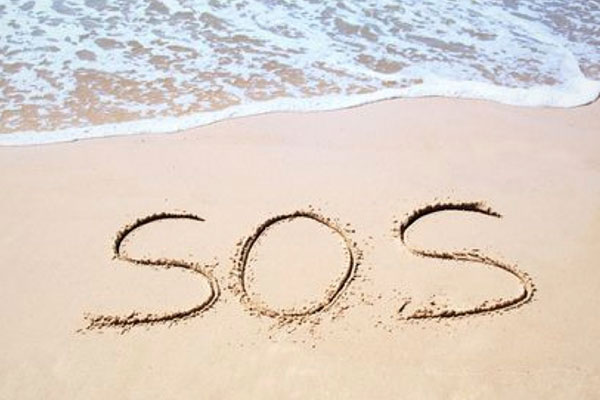
The two best signals to draw out are ‘SOS’ or three parallel horizontal lines. Both of these tell rescuers that you need help no matter where in the world you are stranded.
Motion Signals
Motion signals can work well as long as you are not in a dense forest. There are two primary movement signals that rescuers are trained to spot. One is a flag being waved back and forth. You can use a long pole and any type of fabric or plastic to create a flag. Again, make sure it creates contrast versus your background.
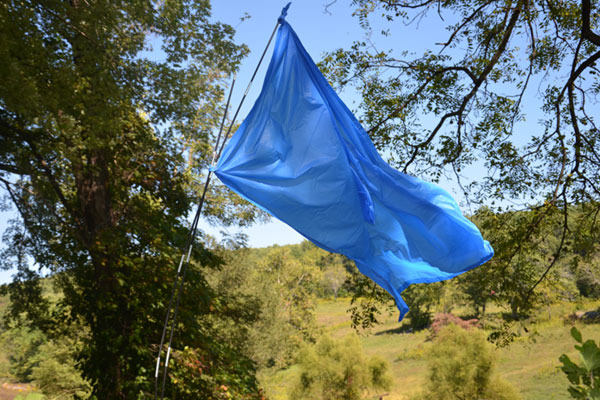
via outdoorlife.com
You likely will not have the energy to continuously wave the flag, so save your energy for when you hear or see rescue personnel in the distance. You can also simply wave your arms back and forth over your head. This is another signal to show that you need help.
Light Signals
Light signals can potentially work in any circumstances but work best at night. This could be a flashlight or the headlights on your car. You are best to create a pattern to show that you need help, and Morse code is universally recognized. By flashing three short bursts, three long bursts, and three short bursts you signal ‘SOS’ to anybody watching. Laser pointers are another option that can reach out to even further distances.
The exception to using a light signal at night is a signal mirror. Signal mirrors are ideal for reaching people at long distances during the day. You can reflect the light from the sun back at a target and signal for help. This works especially well for aircrafts or for ships. Some even have a hole in the center to help you line up and aim the mirror.
Smoke Signals
Smoke signals are one of the oldest methods for signaling that humans have used. For this signal you obviously have to have the ability to create a fire, but that should be a given for a survivalist. There are two priorities for a signal fire. You must have a contrasting color, and you must have a distinct pattern.
For black smoke, you can add plastic, rubber, or just about anything synthetic to create a column of thick black smoke.
For white smoke, you can add any green plant material. This can be any branches, leaves, or grasses that are still alive and full of moisture. The steam from the moisture creates the white color.
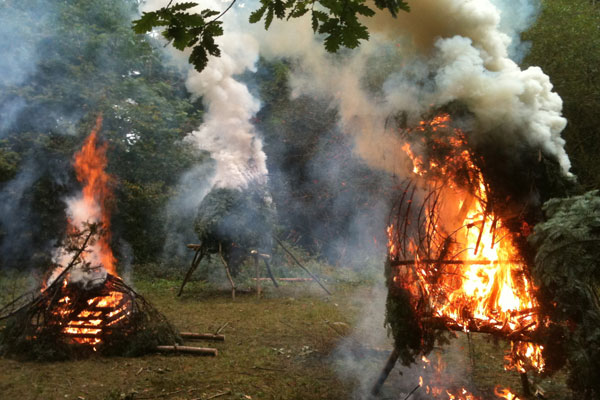
via survivalwisdom.com
For patterns with your signal fire, you have two primary options. You can build three separate fires a good distance apart. The three columns of smoke create a universal signal for distress. Be sure they are far enough apart that they do not combine to make one large column.
You can also use a cover to make plumes of smoke. Hold a tarp or blanket over the fire, let smoke build, and then raise to let the plume rise. You can create an ‘SOS’ pattern just like with the flashlight to alert rescuers. Also, fires create a unique smell that will alert anybody in the area.
Electronic Devices
I know this may be a given, but there are several electronic communication devices that can save your tail. Of course, most people have their cell phones with them all the times. If you have reception, this can be your way to get help. However, it is a good idea to keep a spare battery with you in case yours runs out. If you are in an area with no cell reception, a PLB (personal locater beacon) is a good idea.
![]()
They are a bit pricey, but these devices use a satellite signal to contact authorities and request help. They work regardless of a cellular signal, but need a line of sight to the satellite so stay out from under trees.
Satellite phones work the same way, but allow you to actually have a conversation instead of just pinpointing your location. If you are going to be a short distance from other people, walkie talkies can be ideal if you get lost or hurt. Technology is a great option as long as it works.
Final Thoughts
Your best way to signal for help is by preparing for the worst. This means you should always have a rescue plan. Tell multiple people where you are going and when you will be back. Always have a way to tell where you are located in case you have to dictate that location to somebody else.
Keep electronic devices safe from impact or water. Have tools for signaling with you including whistles, signal mirrors, a flashlight or laser pointer, and a way to start a fire. If you have a rescue plan in place, help is always just right around the bend.
=====
Become a Survival Dispatch Insider …
We bring together survival enthusiasts and preppers to share skills and knowledge, so you can enhance your preparedness for emergencies and ensure the safety of you and your community.
The Results You’ll Get …
Our community, courses, and memberships are pretty special. We focus on the ways it will make a huge difference in your life.
Here are a few of the things you’ll be able to do as a member of Survival Dispatch Insider …
1) Improve your emergency preparedness by learning survival skills and strategies from experienced preppers.
2) Build lasting connections with like-minded individuals that share your passion for safety and readiness.
3) Access a wealth of knowledge and resources to assist in protecting you and your community during unexpected situations.
Click HERE to get started.
=====

1 comment
I’ve considered buying paintball smoke grenades to throw in my backpack, relatively cheap and can put out lots of colored smoke.
Comments are closed.